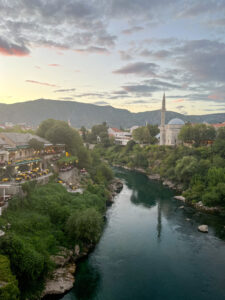
When I was in elementary school, I read a children’s chapter book about Scott O’Grady, a US fighter pilot who was shot down in Bosnia in 1995 over enemy territory and survived it. I must have read it just a few years after it happened. It was the first time I’d ever heard of Bosnia, and I likely had no idea where it was on a map. My takeaway from the book was that this place called Bosnia was a terrifying land where I would never want to be (which I trust was not the author’s intention). And today, over 20 years later, I still remember learning that. What a gift it is to be able to correct perceptions and assumptions and mis-learned lessons.
I knew a little more about Bosnia by the time I visited in August, but honestly not a ton more. I knew there had been a difficult war that ended in the mid-90s, but I didn’t know a lot of details about it. We never learned that history in school—our textbooks were written before the war ended, and I was too young to remember when it was in the news. I knew that Bosnia is now a peaceful country that a lot of budget backpackers enjoy. I knew it contained one of the largest Muslim populations Europe. I knew it’s where the 1984 Olympics took place and where Franz Ferdinand and his wife Sophie were killed sparking the beginning of World War I. And I don’t think I knew a whole lot more than that.

It took us 8 hours on a bus to get from Belgrade, Serbia, to Sarajevo, and for a third of the trip, I was terrified. We were on these tiny mountain roads with impossibly dense fog, and the driver must have been winding his way around the mountain by memory alone because there’s no way he could see more than a foot in front of him. As harrowing as it felt, it also felt for the first time on my trip that I was arriving somewhere entirely different than I’d seen yet. Minarets popped up out of the trees from the mountain villages. Cows walked down the shoulder of the road next to us. We were driving on tiny back-roads—are there even highways here? It felt like we were suddenly somewhere wilder than the Europe I was familiar with. And then we emerged out of the mountains into the valley that is Sarajevo. It was stunning.
There were a lot of reasons that I shouldn’t have liked Sarajevo, and all of them were about bad luck instead of about the city itself. We were only there for about 24 hours, and it stormed on us for a lot of that first evening. We were trying to make it downtown to a walking tour that I had my heart set on doing when we got caught in the kind of downpour that leaves even the bottom of your socks soaked. Of course, the tour was canceled. A couple of hours later, I lost my debit card near the bridge where Franz Ferdinand was assassinated. At least its demise was in a memorable place. But in spite of the back-to-back frustrations, any one of which would typically put a damper on a day, Sarajevo just wouldn’t allow us NOT to love it. The people were unnaturally kind. One person stopped to offer us a ride when they saw us walking in the rain. (We refused, but still.) When we arrived on the doorstep of a fast-food restaurant looking like half-drowned rats, the owner of the place ushered us inside even though we tried to protest so we didn’t drench his floors. He hung my jacket over a bar stool to dry and insisted on giving us whatever food we wanted even though we didn’t have local currency yet and he didn’t accept credit cards. “You pay later,” he said. “Tomorrow. Whenever.” I think the man truly didn’t care if we paid at all. The waiter where we got dinner told us about how he hates the rush people seem to be in these days and how he wants his restaurant to be a place where people sit and visit over his food for 3 hours. That meal made me nearly forget about my long-lost debit card. And then there was the city itself.

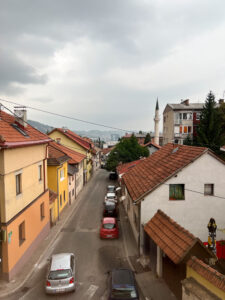
Sarajevo is spectacularly beautiful. The mountains tower over the city on all sides, and the skyline is full of minarets and church steeples. The pedestrian-only Old Town is packed with restaurants and markets with more delicious things than you can eat in a day. In the same city block, you might feel like you’ve stepped back in time into a bustling Middle Eastern bazaar and then like you’re in a modern European city with an incredible food scene. Sarajevo is perhaps the most diverse city I’ve ever seen. It’s a third Muslim, a third Orthodox, and nearly a third Catholic. The church bells ring alongside the call to prayer. And it didn’t look like there was any segregation to it (intentional or otherwise). It just looked like all these people lived peacefully and happily together, being generous and warm and eating burek and baklava joyfully every day (my personal dream). How ironic that that was my perception, because of course it’s far, far more complicated than that.
We took a tour the next day called War Scars, which I recommend to every person who visits the city. Our guide was a little older than me. And this was the first time I heard a person’s first-hand account of the war. Ever since then I’ve tried to learn as much as possible about the Yugoslav Wars, partly because it feels both impossible to understand and important to try, partly because I can’t make sense of having missed this, of how this isn’t taught in schools or talked about as public knowledge now, and partly because I’ve come to love this part of the world, and I want to understand how it came to be what it is today and the ways in which it’s still changing.
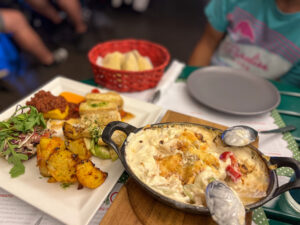
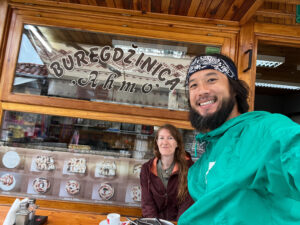
It’s not possible to sum up the war in a paragraph. It’s not even possible to sum up the war in a semester’s worth of college lectures. And I still don’t understand it myself. But here’s a very, very general attempt at the shortest ever version of this. Feel free to correct my very meek effort here! Or feel free to skip 2 paragraphs ahead if you are not here to read a history lesson.
Bosnia and Herzegovina (the country’s full name) used to be part of the country called Yugoslavia before it broke up in the early 1990s. For almost 40 years, Yugoslavia was a socialist country with a beloved leader named Tito. People LOVED Tito. A lot of them still do—the faces of the older people light up when they talk about him. He made socialism work incredibly well, and the country prospered and became wealthy and respected throughout the world. Tito was a peacekeeper and ruled with the mission of brotherhood, equality, and unity. Things were good here. But then Tito died in 1980, and over the next 10 years, the cracks started to show. By the early 1990s, ideas of nationalism were emerging in the region, and corrupt leaders had taken positions of power. And it finally culminated in several different countries that had formerly been unified as Yugoslavia declaring their independence.
A couple of the countries declared their independence with relative ease, but when Bosnia did the same, the Yugoslav army (formerly THEIR OWN army) turned on them. (The reasons are very complicated and have to do with nationalism, cultural memory, religion… I need to find a college class on this and take it myself.) It turned into a siege where the entire city of Sarajevo was surrounded by the Serbian/Yugoslav military. Sarajevo sat in the valley with barely a way to defend themselves. For 4 years, these people hid in their basements with no electricity or running water and waited for mortar shells to fall on their houses. It was relentless and senseless and unimaginably evil. The world watched and did essentially nothing. People had to burn all their furniture and belongings to survive the freezing winters, and every day innocent people were killed by snipers while they tried to go find water for their families. At the end of the 4 years, 8% of the population had been killed, over 12,000 people. The siege only ended after the worst genocide in Europe since the Holocaust where in a nearby town called Srebrenica, the military murdered 8,000 Bosniak Muslim men and boys in like 5 days simply for… existing. After that, NATO stepped in and stopped it. (Which feels like too little too late to me, but they’re still grateful for it.)
The war ended 27 years ago, but you can still see traces of it everywhere if you look for them. You can still see the mortar holes in the roads –they’ve left them on purpose. You can still see bullet holes in buildings. They’ve created monuments all over the city. These people have every reason to be angry. And instead, there’s such a sense of hope here. These people had to figure out a way to keep on living. Our guide said that people here are generally happy because after living through that torture for so long, they are so grateful to know a time of peace. They know not to take what they have now for granted, and they know their future isn’t guaranteed.

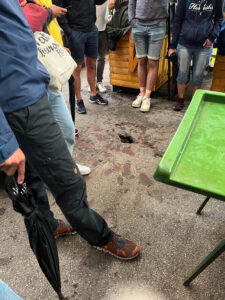
It was all too much to wrap my mind around, and it was time for us to leave Sarajevo before I could grasp all that I’d learned. We took the train from Sarajevo to Mostar, and we made two friends on the way, Pablo and Martin, best friends who live in Germany and have been taking trips together for years. They were trying to wrap their minds around the place, too. The train ride from Sarajevo to Mostar is two hours of peering over cliff edges and feeling equal parts awe and terror. But our 2-hour long conversation with our new pals helped me stay firmly on the awe-side of things. I’m not a person who is skilled at making friends easily (Michael has enough of this gift for both of us), but traveling makes meeting people easy, and the type of people who seek out this type of travel are exactly the type of people you want to be talking to. Not only did I learn about Bosnia that day, but I also learned a lot about European economics, Spain and Germany (where they’re from), language, politics, and how it is worth inviting a couple of strangers from your hostel to share your taxi to the train station.
We only had a couple of daylight hours in Mostar, and we left early the next day, and by then I knew I was in love with the country and needed to come back as soon as possible. So stand by for my return trip to Mostar 2 months later which I originally planned to be 1 night and then somehow turned into 3.
